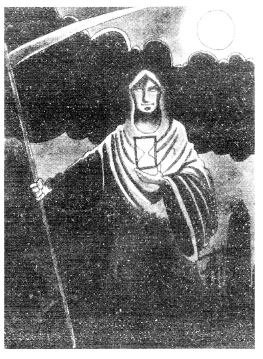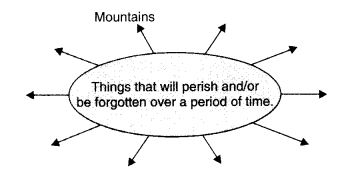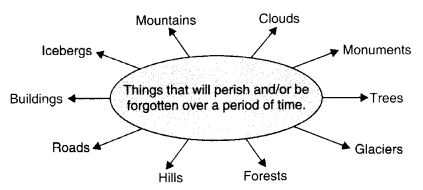NCERT Solutions for Class 10 English Literature Chapter 9 Not Marble, Nor the Gilded Monuments are part of NCERT Solutions for Class 10 English. Here we have given NCERT Solutions for Class 10 English Literature Chapter 9 Not Marble, Nor the Gilded Monuments.
NCERT Textbook Solutions are considered extremely helpful when preparing for your CBSE Class 10 English board exams. NCERT Solutions for Class 10 English Literature Chapter 9 free access available.
| Board | CBSE |
| Textbook | NCERT |
| Class | Class 10 |
| Subject | English Literature |
| Chapter | Chapter 9 |
| Chapter Name | Not Marble, Nor the Gilded Monuments |
| Category | NCERT Solutions |
NCERT Solutions for Class 10 English Literature Chapter 9 Not Marble, Nor the Gilded Monuments
TEXTUAL EXERCISES
(Page 102)
Question 1.
Look at the following picture carefully.
(a) What has Time been portrayed as ? Why ?
(b) What are the other symbols associated with Time ?

Answer:
(a) Time here has been portrayed as a human being having the banner in his hands. It somehow looks like Lord Christ. It has been portrayed so because there is nothing more powerful than man, though man is non-entity before time. Secondly, time has been portrayed as a human being because the poem is meant for them only.
(b) There are other symbols associated with Time, Sun, for instance, Nature and other aspects of Nature.
Question 2.
(a) What are the things that last for centuries ? List a few things around you that will survive four to five hundred years into the future.

Answer:

(b) Think of things that will perish and/or be forgotten with the passage of time.

Answer:

Question 3.
The word “sonnet” is derived from the Italian word sonetto, meaning “a little sound” or “a little song.” A Sonnet is a poem of 14 lines with a structured rhyme scheme in which a thought about a subject is developed thoroughly.
You will read two sonnets on the powerful effects of Time.
Answer:
For students to read. No questions have been asked in it.
Question 4.
Listen to a recording of the sonnet ‘Not Marble, nor the Gilded Monuments’ by William Shakespeare played by your teacher. You could also listen to it on youtube at http://www.youtube.com/watch?v=SOqCaljBhtM&feature=related
Answer:
For students to listen. No questions have been asked in it.
Question 5.
On the basis of your understanding of Shakespeare’s sonnet, answer the following questions by ticking the correct options.
(a) The rich and powerful got ornate monuments made in order to _____
(i) show off their wealth
(ii) display their power
(iii) show their artistic talent
(iv) be remembered till posterity.
(b) The poet addresses his sonnet to _____
(i) time
(ii) war
(iii) the person he loves
(iv) powerful rulers.
(c) In the line ‘The living record of your memory’, living record refers to _____
(i) the sonnet the poet has written for his friend
(ii) an existing statue of his friend
(iii) his friend who lives in the poet’s memory
(iv) the autobiography of the poet’s friend.
(d) The poet’s tone in the poem is _____
(i) despairing
(ii) optimistic
(iii) loving
(iv) admiring,
(e) The poem is set in _____
(i) the place where the poet meets his friend
(ii) a battlefield where Mars is fighting a battle
(iii) a city ravaged by war
(iv) the poet’s study where he is writing.
Answer:
(a) → (iv) be remembered till posterity
(b) → (iii) the person he loves
(c) → (iii) his friend who lives in the poet’s memory
(d) → (iii) loving
(e) → (iv) the poet’s study where he is writing
Question 6.
Answer the following questions briefly.
(a) Why do you think the rich and powerful people get monuments and statues erected in their memory ? (V. Imp.)
Or
Why do the rich and powerful get monuments made ? (CBSE 2015)
(b) Describe how the monuments and statues brave the ravages of time. (V. Imp.) (CBSE 2014)
Or
What according to Shakespeare outlives the ravages of time ? (CBSE 2014)
(c) Why does the poet refer to Time as being sluttish ? (V. Imp.) (CBSE 2015)
(d) The poet says that neither forces of nature nor wars can destroy his poetry. In fact, even godly powers of Mars will not have a devastating effect on his rhyme. What quality of the poet is revealed through these lines ?
Answer:
(a) The rich and powerful people get monuments and statues erected in their memory. They do so for being remembered till posterity.
(b) The monuments and statues brave the ravages of time. However, in doing so they get spoiled, disfigured and broken. This is also if they are not taken care of.
(c) The poet refers to Time as being sluttish because Time spoils the marbled or gilded monuments. It discolours them, breaks them or makes them dirty through its agencies. These agencies are like air, rain, natural vegetation etc.
(d) The quality of the poet is clearly revealed through these lines. It is the immortality of his verse and the permanence of his poetic or literary art. It is true that like Time or = Nature, literary art is also permanent and immortal. That’s why, we have poets and artists through their works who have lived thousands of years before and shall remain ever. They have become immortal through literary art.
Question 7.
Shakespeare’s sonnet has been divided into three quatrains of 4 lines each followed by a rhyming couplet. Each quatrain is a unit of meaning. Read the poem carefully and complete the following table on the structure of the poem.
|
Rhyme scheme |
Theme |
|
|
Quatrain 1 |
(a) |
Comparison between poetry and monuments. |
|
Quatrain 2 |
(b) |
Ravages of time on monuments contrasted with (c)_________ |
|
Quatrain 3 |
(d) |
The recorded memory of (e)______ posterity. |
|
Couplet |
(f) |
Poetry immortalises friend. |
Answer:
(a) ab ab
(b) cd cd
(c) living record of the poet’s beloved’s memory
(d) ef ef
(e) his beloved shall find room even in the eyes of
(f) g g
Question 8.
(a) The poet uses alliteration to heighten the musical quality of the sonnet. Working in pairs* underline the examples of alliteration in the poem.
(b) Identify Shakespeare’s use of personification in the poem.
Answer:
(a) Students to work in pairs. The following information shall help them :
- Unswept stone besmear’d with sluttish time
- When wasteful war
- Nor Mars his sword nor war’s
- Praise shall still
- Lover’s eyes
(b) The living record of your memory’ has been personified here in the sonnet as a man. He shall pace forth against death etc. He shall live even in the eyes of all posterity.
We hope the NCERT Solutions for Class 10 English Literature Chapter 9 Not Marble, Nor the Gilded Monuments help you. If you have any query regarding NCERT Solutions for Class 10 English Literature Chapter 9 Not Marble, Nor the Gilded Monuments, drop a comment below and we will get back to you at the earliest.